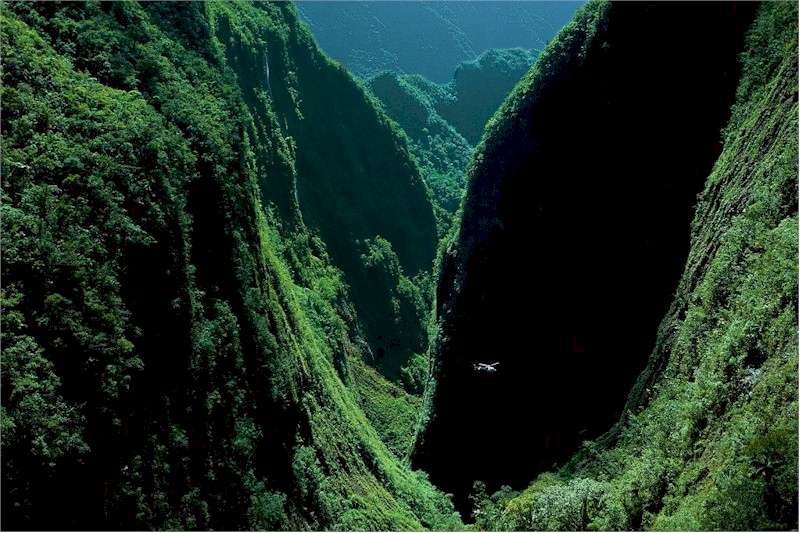Something worth Seeing
Into Velvet CanyonsWe are all islands - in a common sea. - Anne Morrow Lindbergh Though islands appear separate, and may even be situated at great distances from one another, - J Donald Walters
The Gorges of the Bras de Caverne, island of Réunion, France. (S21°01' E55°33') Gorges created from volcanic fractures, like the bed of the Bras de Caverne River, make access to the centre of the island of Réunion difficult. Some sites were explored only recently, such as the Trou de Fer, a ravine of 820 feet (250 m) that was discovered in 1989. Because the island’s centre was protected from human encroachment, its tropical forests, with giant heather, ferns, and lichens, have been preserved, whereas the forests at low altitude have been converted to agricultural or urban use and have disappeared. More than 30 species of animals and plants, of which about two-thirds were endemic, have become extinct on the island in the past 400 years. Although blessed with great biological diversity, insular systems are generally more exposed to the risk of extinction of species than continents. Source: yannarthusbertrand.com from Earth from Above by the incomparable photographer Yann Arthus-Bertrand. Visit his site and be inspired.
Piton de la Fournaise, a shield volcano on the eastern end of Réunion Island, rises more than 8,565 feet (2,611 metres) above sea level and is sometimes called a sister to Hawaiian volcanoes because of the similarity of climate and volcanic nature, has erupted more than 100 times since 1640 and is under constant monitoring. Piton des Neiges volcano, the highest point on the island at 10,069 feet (3,070 metres) above sea level, is west of Piton de la Fournaise volcano. Collapsed calderas and canyons are southwest of the mountain. Like Mauna Kea on the big island of Hawaii, Piton des Neiges is extinct. The slopes of both volcanoes are heavily forested. Cultivated land and cities like the capital city of Saint-Denis are concentrated on the surrounding coastal lowlands. Source: teachersparadise.com
Deccan TrapsThe Deccan Traps is located in west-central India and is one of the largest volcanic features on Earth. It consists of multiple layers of solidified basalt that together are more than 2,000 m thick, and cover an area of 500,000 km?. The Deccan Traps formed between 60 and 65 million years ago, and the gases released in the process may have played a role in the extinction of the dinosaurs. Before it was reduced to its current size by erosion and continental drift, it is estimated that the original area covered by the lava flows were as high as 1.5 million km?. The volume of basalt is estimated to have been 512,000 km?. It is postulated that the Deccan Traps eruption is associated with a deep mantle plume or hot spot. The plume or hot spot caused the continent to break apart, with India drifting north away from the hot spot which now lies under Réunion Island. Source: teachersparadise.com
For more articles relating to Money, Politics and Law including globalisation, tax avoidance, consumerism, credit cards, spending, contracts, trust, stocks, fraud, eugenics and
more click the "Up" button below to take you to the page on "How Many Countries in the World?" Clicking "Up" from there will take you to the Index for this section. |
 Animals
Animals Animation
Animation Art of Playing Cards
Art of Playing Cards Drugs
Drugs Education
Education Environment
Environment Flying
Flying History
History Humour
Humour Immigration
Immigration Info/Tech
Info/Tech Intellectual/Entertaining
Intellectual/Entertaining Lifestyles
Lifestyles Men
Men Money/Politics/Law
Money/Politics/Law New Jersey
New Jersey Odds and Oddities
Odds and Oddities Older & Under
Older & Under Photography
Photography Prisons
Prisons Relationships
Relationships Science
Science Social/Cultural
Social/Cultural Terrorism
Terrorism Wellington
Wellington Working
Working Zero Return Investment
Zero Return Investment